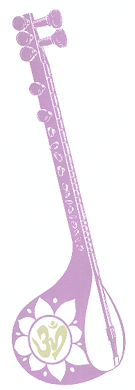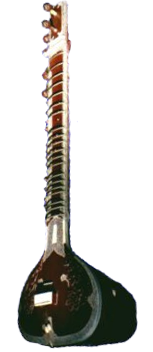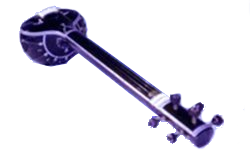
The Sitar, Tabla, and Tamboura
The Sitar
The Sitar is the most popular and respected stringed instrument from North India. The inventor of this amazing instrument was a famous musician and poet: Amir Khusro of the court of emperor Alaudin Khilji. The famous Khilji Empire ruled most of North India in the 13th, 14th, and 15th centuries.
 There were many stringed instruments from the ancient times in India, including the 28 different types of Veenas. The Sitar was inspired in the 14th century from one of them, which was called the Tritantri Veena (means a three stringed Veena, in Sanskrit). In the beginning, it had only three strings, so it was named, "Sehtar", (which also means "three stringed" in Persian). However, its name, design, and many features have changed over the centuries. Today, it is known as "Sitar," and commands the same respect in the East as a violin or piano in the West. It is fashioned from a seasoned gourd (Calabash) and teak wood. On its finger board, there is a track of 20 metal frets along with two sets of strings resting on two bridges - the upper and the lower. On the upper bridge there are seven strings; four for playing the melody, and three for rhythmic variations and resonance. The lower bridge carries 13 sympathetic strings, all for resonance and occasional plucking. These 13 strings are tuned to the various notes of the mode and resonate themselves when the appropriate note is plucked, enhancing the effectiveness of the tone.
There were many stringed instruments from the ancient times in India, including the 28 different types of Veenas. The Sitar was inspired in the 14th century from one of them, which was called the Tritantri Veena (means a three stringed Veena, in Sanskrit). In the beginning, it had only three strings, so it was named, "Sehtar", (which also means "three stringed" in Persian). However, its name, design, and many features have changed over the centuries. Today, it is known as "Sitar," and commands the same respect in the East as a violin or piano in the West. It is fashioned from a seasoned gourd (Calabash) and teak wood. On its finger board, there is a track of 20 metal frets along with two sets of strings resting on two bridges - the upper and the lower. On the upper bridge there are seven strings; four for playing the melody, and three for rhythmic variations and resonance. The lower bridge carries 13 sympathetic strings, all for resonance and occasional plucking. These 13 strings are tuned to the various notes of the mode and resonate themselves when the appropriate note is plucked, enhancing the effectiveness of the tone.
The Tabla
 There are many types of percussion instruments in India. The Tabla is a two-piece drum, and is very popular today. The original and ancient rhythm instrument was called the, "Pakhawaj," and is still used today. And again, it was the genius of Amir Khusro, the inventor of sitar, who cut the single body of the Pakhawaj in two and designed the modern Tabla.
There are many types of percussion instruments in India. The Tabla is a two-piece drum, and is very popular today. The original and ancient rhythm instrument was called the, "Pakhawaj," and is still used today. And again, it was the genius of Amir Khusro, the inventor of sitar, who cut the single body of the Pakhawaj in two and designed the modern Tabla.
The right-hand drum is called the Tabla, and the left-hand drum is called the Bayan (nasal "n"). Both the heads are designed from treated skin and are tightly stretched over the open ends. A small hammer is used to tune the Tabla and Bayan.
The Tabla is an accompanying instrument for vocal and instrumental music. It is capable of producing a variety of tones, syllables, and rhythmic phrases which add a special charm to the music.
The Tamboura
 The Tamboura is one of the most ancient instruments of India. It has four to six strings and comes in various sizes. The purpose of the Tamboura is to provide the essential drone effect in a sustained manner. Seemingly very simple to play, this instrument requires tremendous focus, control, and concentration in order to play, so that it will complement and not disturb the tonal structures and the interplay of notes of the melody (Raga).
The Tamboura is one of the most ancient instruments of India. It has four to six strings and comes in various sizes. The purpose of the Tamboura is to provide the essential drone effect in a sustained manner. Seemingly very simple to play, this instrument requires tremendous focus, control, and concentration in order to play, so that it will complement and not disturb the tonal structures and the interplay of notes of the melody (Raga).
"I have heard many good singers and instrumentalists, but have heard only a few exceptional Tamboura players in the last 40 years of my journey through the world of music."
-Roop Verma
